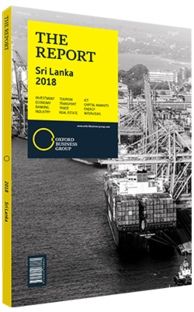Sri Lankan stock market outlook
Sri Lanka had a challenging year in 2017, with GDP growth slowing notably to 3.3% in the third quarter, from 4.6% during the same period the previous year. The country was affected by a series of natural disasters and a dengue fever epidemic, which impacted tourist arrivals, retail, construction and agriculture, while driving the inflation index to highs of 7.8% in October. Together with the economic slowdown, cumulative earnings growth of listed companies saw a weakening from 11% year-on-year in the fourth quarter of 2016 to a respective 7% and 9% in the first and second quarters of 2017. In the third quarter of 2017 this eased to 2% – representing the slowest expansion in eight quarters. The current tight monetary policy has also dampened the economy and disturbed earnings.
However,macroeconomic improvements are expected towards the second half of 2018, with GDP growth targeted to reach 5%. In line with GDP, earnings performance in listed entities is expected to improve to a modest 5-7% in FY 2018/19, supported by the recovery in economic performance in the second half of 2018. This is likely to accelerate to 10-12% towards FY 2019/20, backed by improvements in macroeconomic indicators following the easing of monetary policy.
Valuations
The Colombo Stock Exchange (CSE) has seen some bumpy moves since the beginning of 2017. Yet, the All Share Price Index (ASPI) gained 3% from January-December while the Standard & Poor’s Sri Lanka 20 (S&P SL20) gained 6%. This followed two consecutive years of negative returns, with the ASPI and S&P SL20 falling by 6% and 12%, respectively, in 2015, and dropping by 9% and 3%, respectively, in 2016. Among the factors that reinforced investor confidence were steady policy implementation, the sale of Hambantota Port, the approval of the fourth tranche of an IMF loan, and an upgrade in the credit ratings outlook from negative to stable by ratings agencies Fitch and S&P.
Valuations on the CSE in 2017 offered opportunities at an average market price-to-earnings (P/E) ratio of 11x, which was a significant decline from 17x in 2015. The average price-to-book value (PBV) was 1.4x, down from approximately 2.1x in 2015. Dividend yields increased from roughly 2% in 2015 to around 3%.
Regionally, the NIFTY 500 traded at an average P/E ratio of 29x with a PBV of 3.3x. Meanwhile, Thailand averaged a P/E ratio of 17-18x, with a PBV of 2x, leaving Sri Lanka as an attractive window. Many foreign investors have already tapped this opportunity; as evidenced by net foreign inflows of close to LKR18bn ($117.5m) in 2017. The exemption from capital gains taxes remains an attraction for global investors.
Market returns are likely to be slow but positive in the first half of 2018 due to attractive valuations. We expect overall market returns to be 10-12% above the expected earnings performance as the market re-rates with the promise of a better macroeconomic landscape heading into 2019. Returns are expected to accelerate to 15% due to boosted earnings performance and renewed investor confidence on the back of the policy reform agenda continuing into 2018.
Key Sectors
The banking sector is expected to yield attractive earnings growth as interest rate volatility smooths out with continued bearish sentiment. Many large banks have strengthened their capital base, preparing for the full implementation of Basel III standards. Construction is forecast to pick up, in turn reviving the building materials sector. With Sri Lanka set to welcome 4.5m tourists by 2020, an estimated 41,000 rooms need to be added to the hotel inventory, with at least 5000 condominiums expected to be sold. The Port City Colombo and the Western Region Megapolis development projects will continue to be a boon for the construction sector. The apparel sector is also likely to progress thanks to the reinstatement of EU Generalised System of Preferences Plus status. The apparels sector, which contributes approximately 47% to total exports, has already seen a 10% boost in goods sent abroad, a trend that is expected to continue going forward.
You have reached the limit of premium articles you can view for free.
Choose from the options below to purchase print or digital editions of our Reports. You can also purchase a website subscription giving you unlimited access to all of our Reports online for 12 months.
If you have already purchased this Report or have a website subscription, please login to continue.

